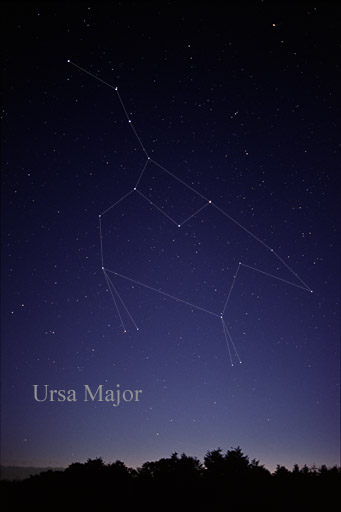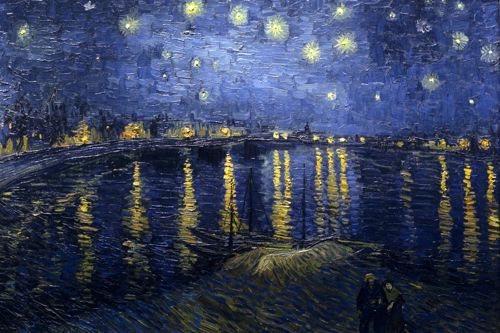Tonight … a constellation you might or might not see, depending on your latitude. In the Northern Hemisphere, the Big Dipper is probably the sky’s best known asterism. In other words, it’s a recognizable pattern of stars – not an official constellation. The Big Dipper is part of the constellation Ursa Major, otherwise known as the Great Bear.
Every year, the Big Dipper (Great Bear) descends to its lowest point in the sky on November evenings. In fact, people in the southern part of the United States can’t see the Big Dipper in the evening right now, because it swings beneath their northern horizon.
And, of course, it can’t be seen in the evening from Southern Hemisphere latitudes now either.
EarthSky lunar calendars are cool! They make great gifts. Order now. Going fast!

Image via AlltheSky.com.
Even in the northern states, the Big Bear is hard to spot. The Big Dipper skims along the northern horizon in the evening, ducking behind any obstructions – such as trees and mountains.
To the Micmac Indians living in southeast Canada, a Celestial Bear – our same familiar Big Dipper pattern – coming down to Earth signaled the start of hibernation season. This is when earthly bears return to their dens, and when the sap of trees returns to the warm womb of the underworld. Weary creation tucks in, waiting for winter’s deep slumber.
The Micmacs saw the Big Dipper handle stars as hunters forever chasing Celestial Bear. In their sky lore, hunters catch Celestial Bear each year in the fall, and it’s the dripping blood from the Bear that colors the autumn landscape.
Donate: Your support means the world to us

View larger. | Another portrayal of the Big Dipper in November. It’s Vincent van Gogh’s Starry Night Over the Rhone, painted in September 1888 at Arles. Had you noticed the Big Dipper in this painting? Can you see it tonight?
Bottom line: The Big Dipper is difficult, or impossible, to see on November evenings. If you’re in the southern U.S. or a similar latitude around the world, the Dipper is below your northern horizon in the evening now. If you’re in the northern U.S. or a similar latitude, the Big Dipper may be above your horizon in the evening, but it will be low in the northern sky.
Donate: Your support means the world to us
from EarthSky https://ift.tt/2DfQDbF
Tonight … a constellation you might or might not see, depending on your latitude. In the Northern Hemisphere, the Big Dipper is probably the sky’s best known asterism. In other words, it’s a recognizable pattern of stars – not an official constellation. The Big Dipper is part of the constellation Ursa Major, otherwise known as the Great Bear.
Every year, the Big Dipper (Great Bear) descends to its lowest point in the sky on November evenings. In fact, people in the southern part of the United States can’t see the Big Dipper in the evening right now, because it swings beneath their northern horizon.
And, of course, it can’t be seen in the evening from Southern Hemisphere latitudes now either.
EarthSky lunar calendars are cool! They make great gifts. Order now. Going fast!

Image via AlltheSky.com.
Even in the northern states, the Big Bear is hard to spot. The Big Dipper skims along the northern horizon in the evening, ducking behind any obstructions – such as trees and mountains.
To the Micmac Indians living in southeast Canada, a Celestial Bear – our same familiar Big Dipper pattern – coming down to Earth signaled the start of hibernation season. This is when earthly bears return to their dens, and when the sap of trees returns to the warm womb of the underworld. Weary creation tucks in, waiting for winter’s deep slumber.
The Micmacs saw the Big Dipper handle stars as hunters forever chasing Celestial Bear. In their sky lore, hunters catch Celestial Bear each year in the fall, and it’s the dripping blood from the Bear that colors the autumn landscape.
Donate: Your support means the world to us

View larger. | Another portrayal of the Big Dipper in November. It’s Vincent van Gogh’s Starry Night Over the Rhone, painted in September 1888 at Arles. Had you noticed the Big Dipper in this painting? Can you see it tonight?
Bottom line: The Big Dipper is difficult, or impossible, to see on November evenings. If you’re in the southern U.S. or a similar latitude around the world, the Dipper is below your northern horizon in the evening now. If you’re in the northern U.S. or a similar latitude, the Big Dipper may be above your horizon in the evening, but it will be low in the northern sky.
Donate: Your support means the world to us
from EarthSky https://ift.tt/2DfQDbF

Aucun commentaire:
Enregistrer un commentaire